Vol. VII • 1984 http://www.creationism.org/csshs/v07n4p06.htm
A Synthetic Interpretation of A North American Indian
Flood Account: The Ark Upon a Rock
Ross S. Marshall
A Synthetic Interpretation of A North American Indian
Flood Account: The Ark Upon a Rock
Ross S. Marshall
Introduction to Panel
Archaeological scientists have come to understand that there was greater advancement in learning and maritime activity among ancient peoples than was formerly believed. It is now understood that there were great migrations and colonizations of all the continents during the centuries following the Noahic Flood. The maritime works of the Egyptians, Chinese, and possibly the Sumerians show us that Noah and his sons were fine craftsmen in the art of shipbuilding. Thus in a monogenetic scheme, descendants of Noah were emigrants who colonized and built the empires of Egypt, China, India, and Europe.
But let us now look to some interesting parallel evidence from early America where a very ancient rock inscription was left by some emigrant or surveyor in the desert area of lnyo county, California one of many major Sites of petroglyphs (pictographic writing, or "rock art".)
Evidently after traveling many thousands of miles and settling down on the coasts of the New World, these emigrant surveyors (descendants of the Biblical) Noah) eagerly scratched and chiseled the many adventures and Stories of their people along with maps1, star charts2, zodiac signs3, and other survey markings, zoomorphic signs, and motifs.
The particular inscription in lnyo County, California4, seems to depict a large water-craft, a ripple of water, and a hilltop with some additional characters in the vicinity. This apparently alludes to some ancient flood tradition in which a great ship has come to rest upon a hill or mountain top. Thus sometime between the Flood and the establishment of the first standardized letters and the major ancient cultures. these colonizers were at work inscribing notations on the rocks of America, Africa, and elsewhere. Such mysterious writings upon the rocks of both hemispheres could very well be the most ancient of all writing systems, a lost international system which would antedate the standardizing of alphabets and even the confusion of tongues and dispersal of people from Babel.
It is a common understanding among language experts that the first writing systems were indeed pictographic5 and that all later ones (such as the Egyptian Rebus and the cuneiform scripts) had their origin from this root picture language.
The many similarities of Style in pictographic writings from such diverse places as Spain, TransJordan, and the Americas make it very difficult to deny the monogenetic hypothesis of racial origins as also seen in Scripture. Accordingly, it was only after the Lord in Heaven had divided and scattered the people that the international or common world language was lost and this is what evidently caused the confusion among the already existing national Ianguages. Perhaps the ancient languages that still remain (such as Egyptian, Sumerian, and early Chinese) could shed light and clarity of translation on these mysterious inscriptions. I shall attempt just this in translating the ancient lnyo county Rock Panel. Such similarities are not just mere coincidences as can be seen by comparison of the grammars of the Mayan and Akkadian peoples6; the art of Central America and that of the ancient Near East 7; the religious beliefs of the Hopi and those of the peoples of East India and China.8.
It should also be understood at the onset that there have been many attempts to decipher and translate numbers of these rock inscriptions. Many well-known art historians, popularizers, journalists, and others have contributed information toward understanding these mysterious inscriptions. In this paper, however, I have attempted to combine such background knowledge with a strong Biblical basis. Thus I oppose the idea that all Indian Rock Art must be classed as "religious conceptual art" or "art for art's sake" but should be approached instead from the standpoint of studying an ancient "artistic" system of writing. And it goes without saying that we should oppose the idea that such inscriptions can be brushed off as mere "rock doodlings" like Some have assumed.9.
These carvings instead are made up of signs and symbols that have definite meanings and messages of which the panel translated here is merely one example among hundreds of others. Thus I am attempting to give some explanation to the mysterious Indian Rock Writing in the context of early post-Flood migrations to, and explanations of, the New World.
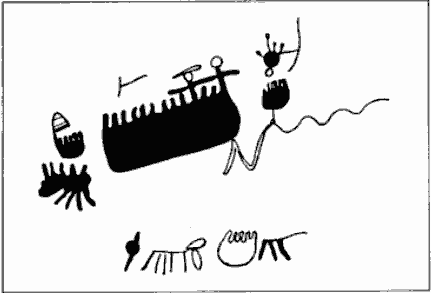 Introduction to Chart I (Petroglyph)
Introduction to Chart I (Petroglyph)
The photostatic copy of this petroglyph is found on p.349 in the collected works of Robert Heizer and Martin Baumhoff, Prehistoric Rock Art of Eastern California and Nevada10.
As indicated earlier, the petroglyph itself was found on a rock in lnyo County, eastern California. I believe it tells the story of a large boat with occupants. The boat was engulfed in a flood or large body of water, only to come to rest upon some mountain peak or hill. See Panel I for a translation of this petroglyph. A Biblical parallel to the rock panel will be found in the following verses of Genesis; 7. 17-20, 24, and 8:2-6. 13, 17, 19-20, New American Standard Version.
Translation of the Boat Glyph
The first and most impressive symbol of the petroglyph was the large boat symbol (7). Please note that this symbol (7) and all other numbers in parentheses hereafter do not refer to footnote reference numbers but to particular components of the rock message as interspersed in the text itself and summarized in the "Sign List Translation" found in the Appendix of this paper. Numbers in the text without parentheses refer to bibliographic references found in the reference list.
The second and most recognizable symbol was the water sign (1). The relationship between the water Symbol and the boat resting on the mountain or hill reminds one of the Genesis account of Noah's Ark and the Flood.
Egyptian Relationship
Study of an Oxford Text on Egyptian grammar11' convinces one that symbol (1) was a universal symbol for "water" or "flood". thus the water symbol is not only the Egyptian alphabetic letter "n" but is also a designation for water on almost a universal basis.
Symbol Combinations
Looking again at Panel 1 we see that the water symbol 1) has been attached to the top of what appears to be a mountain (9). I assume that this represents Mount Ararat (Genesis 8:4). Thus by attaching his craft to the top of a mountain, the rock artist conveyed the ideas of Genesis 7:19 and 20. The connecting of the two symbols shows graphically that the waters prevailed above the mountains!
Here we have a good illustration and translation of the glyphs in Panel land can come to a better understanding of what the writer was saying.
Sentence Beginnings and Endings
I have noticed two signs which are similar but opposite in direction: (6) and (13). Remembering that much ancient writing moves from right to left, I have concluded that symbol (6) implies the "beginning" of the story and (13) signifies the "end". Thus these two glyphs convey the time frame within which the story unfolds. I would equate symbol (6) to Genesis 7:10, And it came about after seven days. . and symbol (13) to Genesis 8: 4-5, , . the Ark rested upon the tops of the Mountains of Ararat. Thus (6) and (1 31 respectively are the Indian counterpart to the Scriptural words "came" and "rested" signifying the beginning and the ending of the Ark's journey on the Flood waters.
A Time to Rest
Looking at Sections A and B of Panel I, we find that there is a smaller Ark which rides upon the waters. Thus there must be divisions of thought throughout the pictographic text, as we will discuss later. By dividing sections A and B from each other, I have located two different thoughts on the Ark.
First, in Section A, Panel I, there is a little symbol (2) that illustrates the Ark is riding or floating on the water. The little round symbol is connected to the Ark by a short line. I conclude that the round sphere illustrated the tact that the Ark was floating a type of ancient "verb". This would indicate that the connecting line is a type of "transitional sign" between two determinatives. Apparently it was intended to show that the Ark was "floating" instead of resting or touching the mountain peaks. Thus the water sign (II is connected to the small ark (31 by the sphere and connector (2).
Second, the reason that the smaller boat glyph (3) is not touching the water in the same manner as the larger one (7) is that the scribe intended to convey the idea that the Ark was "riding" and not just touching or resting. This whole contrast of the boat "riding" but finally "resting" (8) is distinguished by the use of two contrasting graphic elements. Thus there emerges a startling clarity of communication in very simple artistic form.
Rainy Days and Rainy Nights (Time Table)
There is a good possibility that the symbols (4) and (5) could have referred to the forty-day period during which the Ark floated on the waters or it might have referred to the length of time the rains lasted. Symbols (41 and (51 are considered to represent "Days and Nights." In this context, I came across the Indian symbol (20) in LaVan Martineau's book, The Rocks Begin to Speak.'2 Symbol (201 means "Empty," "Nothing in it," and "Hollow." It was also incorporated into the Sumerian languages, where it meant "Cave."'3
Also in LaVan Martineau's same work, p.16, is the American Indian symbol (22) meaning "Something There." Note the difference (and yet distinctly parallel form) in the Egyptian Symbol (21) which means "Filled" or "Channel Filled with Water."8
These similarities and differences between Egyptian and American Indian symbols would support the idea that the Egyptian language was an offshoot from a one world language (Genesis 11: 1, 6, and 7) which broke away and became isolated. The Egyptian alphabetic symbols were then changed and shaped into a more standardized form within that particular culture. separate from but with similarities to Sumerian.
In changing their symbols, the Egyptians found it easier to leave it (21) an open and clear looking sign. perhaps thus saving work. So, we now have one open symbol (20) that stands for "Nothing inside" and two symbols (21 and 22) that mean "Something There" or "Filled with Something."
Solar Disc Signs
Symbol (23a) from p.125 of James Churchward's The Sacred Symbols of Mu14 is the Indian symbol for "Sun" or the collective symbol of "All the attributes of Deity." Symbols (23-b) and (23-c? give more proof of the same meaning. Thus it may be assumed that the circle symbol translates as "Sun" or "day."
Symbol (24? probably means "The sun has gone down behind the horizon," or "Night time" Churchward.15 Thus I believe that symbol (5) shows the darkness filling the emptiness of space another way of saying "Night." Thus the blackening-in of a symbol apparently meant that Day became filled with Night.
These two signs should also be compared with the Sumerian symbol (20), the Indian symbol (22), and the Egyptian symbol (21) along with the two symbols for the Ark (3) and (7). Here the "Night" symbol is filled with darkness and the Ark symbols are filled with animals.
Night Symbols with Rays?
There seem to be lines radiating from the "Night" symbol that we have just translated. having dots and empty circles attached. Perhaps symbol (4) means "Day" and (5) "Night" in such a fashion that the open dots could mean two Sets of 20 days while the other two means two sets of 20 nights. as we would have rain far 40 days and 40 nights.
The Waters Subside
Sign (13) is quite likely an ending sign, telling us that the Flood ended and that the waters subsided and the Ark's journey came to an end. We should note as well that sign (11-a) indicates that the water subsided, while signs (7), (8), and (9) mean that the Ark came to rest on the tops of the mountains. Signs (10), (11), and (12) indicate that Noah, Noah's wife, and their family (respectively) were on board the ark, together with the various animals. Thus the two human figures are the primeval father and his wife. The great number of appendages or small figures (12) support this concluSion likewise -zoomorphic determinatives for animals and people. The joining of hands between the two key figures may be Symbolic of their marriage union meaning "Bound Together."
We also note that one of these figures has some sort of head covering or hat which evidently symbolizes the royal wife Noah's wife. Such distinctions were evident into Bible times and even down to the present.9
Sacrifice vs. Dispersal of Animals
In the left hand corner of the panel are two most interesting figures (14) and (151. My conclusion is that symbols (14) and (14-a) imply the following information which runs closely parallel to the Biblical account: "After opening the canopy and finding that the waters had cleared, Noah opened the `doorway' to the Ark, freeing all of the animals and all of the occupants (his family)." See Genesis 8:6 and 8:13-19.
The next symbol, (15), may mean one of two things in relation to the Biblical record of the Ark. first, it may mean: "a sacrifice on an altar" or secondly. "a dispersal of animals from the Ark" (see Genesis 8:20 and 8:19).
I believe that the dispersal idea is most likely since it is more direct and more in keeping with the rest of the record in the symbols. The Indian artist was condensing and simplifying, and it would seem that the dispersal of animals would be a more salient point than the post-Flood sacrifices.
In context of the whole story. symbol (14-b) appears to be a "doorway" (in keeping with the dispersal interpretation). This would tie symbols (3), (141, and (151 together as all referring to the Ark and its inhabitants. Since (15), (14), and (3) all have the same general shape. this supports the idea that the author was attempting to standardize the glyph throughout the entire pictographic panel. Coming from the bottom of symbol (15) are 4 rays and this might indicate that the post-flood world was divided into 4 kingdoms Noah's and each of his three sons.
The Use of Black and White
The black or white effect superimposed upon a glyph may convey some special meaning in relationship to that particular glyph. The "blackness" or "whiteness" is communicated by either leaving the pecked or painted symbol intact or by chiseling out the interior sections(s) of the glyph as in (3), (5). (7), (1 5), and (19). The relation of such chiseling can mean almost anything and must be interpreted in context with the glyph on which it is used.
Two of the most probable usages are that "blackening-in" or chiseling of the interior may mean that it is "containing" something (a kind of contents) In this same patterning the "whitening-in" or jack of chiseling would mean the glyph is minus the subject content and could very well symbolize "empty". Thus one ark glyph (3) is dark or chiseled and the other (17) is white. The obvious interpretation of a full ark at the onset and an empty one at the conclusion is very tempting.
On page 17 of Introduction to the Study of Mayan Hieroglyphs 16 the author discussed the Mayan god "BAREBONES" (AHPUCH), the Lord of death. A Study of the black Spots or dark places indicates that the god contained death, that he had death or was filled with death.
Thus black and white may be used as types of:
(1) adverbs: as in FULL AND EMPTY
(2) adjectives: as in FILLED AND EMPTIED
(3) verbs: as in TO FILL AND TO EMPTY'
(4) gerunds: as in THE FILLING OR EMPTYING
In context with all of this we may return to the boat symbol and note that the black means "being filled with" or "containing something" in this case, animals.
The Planet Symbol Compared with the Boat Symbol
The glyph signs 1 9-a and 1 9-b illustrate this same phenomenon. Thus (19-a) is a symbol for an occupied or populated planet and (19-b) is a vacant planet.
Here, as with the boat symbol, the blackening in stands for filling.
The Animal (Zoomorphic Figures)
By observing the petroglyph panel, section (E), one notes two symbols (16) and (18-b) that seem to stand for animals. Apparently (16) stands for the singular (animal) and (18-b) for the plural.
At this point we must then ask what the added appendages signify I 18-a) and the double-stroke marks (18-c). Evidently they carry incorporated meanings that modify the basic glyph or pictogram. These extra lines may signify "multiplication" and could thus refer to the offspring of a parent. This would be the reason for the separation between symbols (18-b? and (18-c). Along this same line of thought, the small double sign has a close affiliation with the basic animal yet has a Separate identity of its own. Thus these extra doubled lines may refer to the legs of the offspring rather than the legs of the parent. At this point the reader should compare this simplified American Indian form which is graphic and non-representational with the Egyptian which is representational and has an intricate, detailed form (see comp. 18 and sign #32 following illustration.
It is likewise possible that (18-a) symbolizes the conception of a birth. The birth sign (18-c) is thus connected to the end of the animal, representing the fruitful multiplication of the animals that left the Ark. Thus the sign (18-c) has an affinity to the Egyptian hieroglyphic symbol for "more than one" the double stroke (see Sign List and Translations symb. 33 and 34).
The Two Arks in Relation to the Animal Signs
Thus the Indian hieroglyphic sentence below the large Ark (7) Section E -evidently illustrates the dispersal and multiplication of animals from the Ark of Noah. It tells us that this all happened "after" the Ark came to rest and after the waters subsided because the Ark is empty (17). The animal glyph (16) may be telling us that each animal left the Ark on its own or with its own family.
The Planet or Earth Symbol
Symbol (191 illustrates a heavenly body, probably the Earth. One reason to accept this idea is that the planet has been inscribed with only one orbiting satellite. Had it been meant to represent some other planet with more than one moon, it might have been drawn as in (281, (29) or (30). The writer is intending to portray a full planet by using the blackening effect that we have already discussed an admission of the fact that the earth was repopulated with animals and other life after the flood.
A parallel situation can be found in the pictographic writings of the Dakota Indians. Thus the symbol (31) means four black crows. If some planet other than earth had been intended, I believe the writer would have shown four orbits as I suggested in Symbol (31.
Visual Points of Interest and Division
There are several distinct divisions in idea and thought in this petroglyph. Thus there are four Arks, one of which is apparently "empty" and the other three "filled." Our picture can accordingly be divided into two thoughts. Section Band Section E. The writer directs our thoughts from "full" to "empty" in reading from right to left, as shown in Chart 2.
There is another division in terms of the Ark first floating on the waters and later coming to rest on the mountain top (1,2, and 3) versus (7, and 9). Thus section A concerns itself with the waters subsiding and the Ark coming to rest on the mountains. Section D, in which the Ark is full, speaks of the dispersal of animals. Section E, as we have lust translated. conveys the ideal of an empty Ark with animals multiplying and filling the earth Consult Chart 3.
Thus in writing this story of the Ark and its journey, the Indian has led us from the start to the finish finally to the dispersal of animals (15). Chart 4 illustrates the way the message is read and the path the eye must follow in the process. We note also how the author has repeatedly used the same ideograms to further the accounts. Our thoughts are directed back to the same symbols. This helps, of course, in simplification of the whole pictograph and condenses the story into one convenient portrait or illustration.
These Indians incorporated their own signs into a new style of picture writing that can be compared favorably with that of the Mayans and Aztecs as welt. In fact, this system that we have analyzed from California Indians was in some senses a more flexible style of writing than those manifested by their South American relatives. It may now well be a matter of debate for researchers to decide how these linguistic stocks connect and which group was ancestral.
As it stands, we have on permanent record, in a most obscure desert region a testimony and memorial to the greatest catastrophy which has befallen mankind the universal Flood of Noah which was accompanied by the salvation of mankind through the Noahic family.
Acknowledgements
Although taking full personal responsibility for the text and its contents, I wish to thank Dr. George Howe for his encouragement in this research, his constructive criticism and his assistance in preparation of this manuscript.
FOOTNOTES
1 Stirnemann, Erich. 1956. Correspondence with Petrified Forest Museum. Holbrook, Arizona Unpublished Museum File Papers on Inscription "Newspaper, Rock. Correspondence shows Newspaper' Rock to be a map and chart of the Hudson Bay and Hudson River area with Indian camp sites, migration routes, and major settlements. The inscriptions have many examples of Runes.
2 Any book on Chumash Rock Art.
3 Fell, Barry. 1977. America B.C. Quadrangle Books, N.Y. Times Book Co. Translation of rock panel of Zodiac Signs and Constellations.
4 Heizer, Robert and Baumhoff, Martin, 1062. Prehistoric Rock Art of Nevada and Eastern California. University of Calil. Press, Berkeley, facsimile drawing of Ark panel, p.349.
5 Waddell, L.A. n.d. Aryan Origin of the Alphabet. Christian Book Club of America, Hawthorne, CA 90250, p.55.
6 Le Plangeon, Augustus. 1900. Queen Moo and the Egyptian Sphinx. reprint 1972, Health Research, P.O. Box 70, Mokelumne Hill, CA 95245.
7 Jairazbhoy, R.A. 1974. Ancient Egyptians and Chinese in America. G. Prior Assoc., Pub. Ltd. London. pp.34-43. See also Harris, H.M. 1974. Asiatic Fathers of America, Vol.1 and Chinese Discovery and Colonization of Ancient America. Vol.2. Wen Ho Printing Co., Ltd., Taipei, Taiwan, R.O.C. see Vol.2, pp.21-30.
8 Ibid. Harris, Vol.1, pp.36-37.
9 Fell, Barry, Robert L. Pyle. and Ida Jane Gallagher. 1983. Wonderful West Virginia. See articles on rock inscriptions.
10 Heizer, and Martin, op. cit., (see ref. 4 above).
11 Gardinar, AH. 1950. Egyptian Grammar, Oxford Press.
12 Martineau, LeVan. 1973. The Rocks Begin to Speak. K.C. Publications, Box 14883, Las Vegas, Nev. 89114-Desert Press. p. 46 with Fig. 22, p.36.
13 Ibid. p.152, chart 6, symbol 4.
14 Churchward, James. 1 933. The Sacred Symbols of Mu. Paperback Lib., N.Y. p.125.
15 The Lost Continent of Mu. Paperback Lib., N.Y. pp.172-3.
16 Morley. S.G. 1975. An Introduction to the Study of Mayan Hieroglyphs. Dover Publications. N.Y.
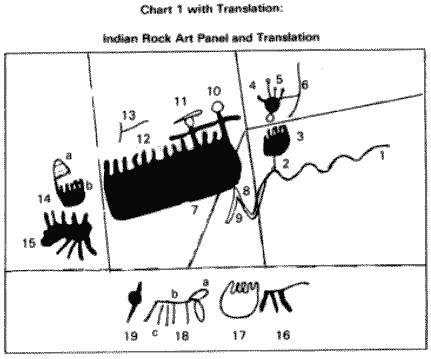
Translation:
In the beginning (6) the waters (1) Rose to the tops of the moutains (2, 8, 9). The Ark rode the waters (3) for some days and some nights (4,5). As the waters subsided (1,2,8,9), the Ark (7) came to rest (3) on a mountain (9) with Noah (10) and his wife (11) and all his family (12) at the end of the waters/folld (13,1). After the waters subsided and the land had dried up, Noah opened the window and removed the covering (the doorway) (14a) and freed (15) all the animals and the people (12,11,10). As each pair of animals (16) vacated the Ark (17) they (the animals, 18c) multiplied (18a) and populated (filled) the (lands of) the planet (Earth - 19).
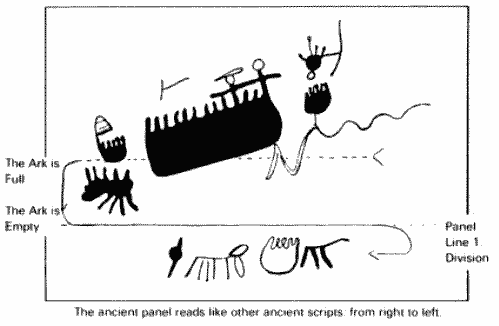
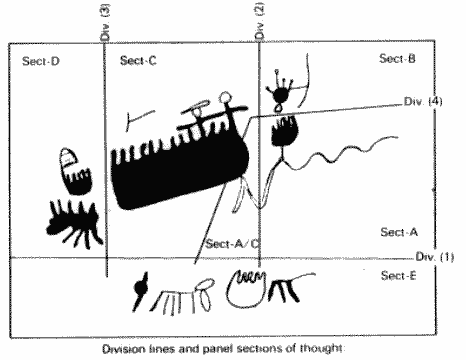
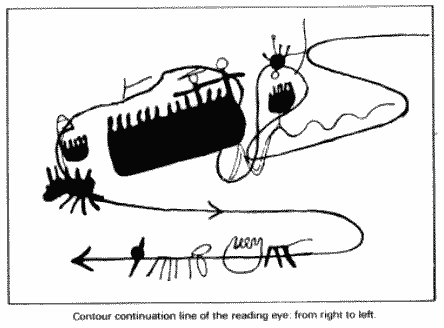
|
|
|